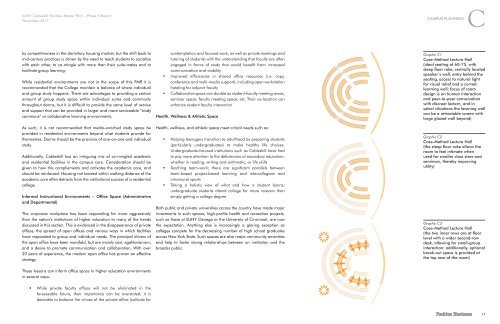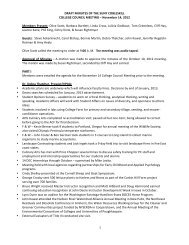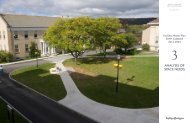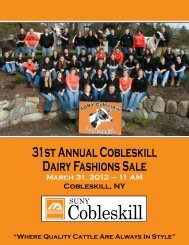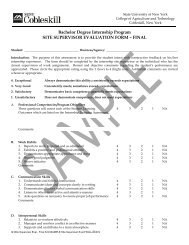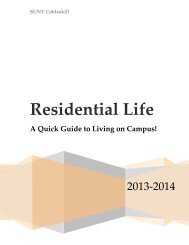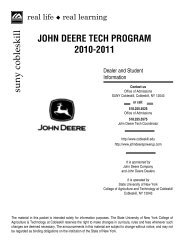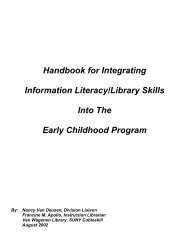Part 5: Final Recommendation - SUNY Cobleskill
Part 5: Final Recommendation - SUNY Cobleskill
Part 5: Final Recommendation - SUNY Cobleskill
You also want an ePaper? Increase the reach of your titles
YUMPU automatically turns print PDFs into web optimized ePapers that Google loves.
<strong>SUNY</strong> <strong>Cobleskill</strong> Facilities Master Plan – Phase 5 Report<br />
November 2011<br />
CAMPUS PLANNING<br />
C<br />
by competitiveness in the dormitory housing market, but the shift back to<br />
mid-century practices is driven by the need to teach students to socialize<br />
with each other, to co-mingle with more than their suite-mates and to<br />
facilitate group learning.<br />
While residential environments are not in the scope of this FMP, it is<br />
recommended that the College maintain a balance of where individual<br />
and group study happens. There are advantages to providing a certain<br />
amount of group study space within individual suites and commonly<br />
throughout dorms, but it is difficult to provide the same level of service<br />
and support that can be provided in larger and more serviceable “study<br />
commons” or collaborative learning environments.<br />
As such, it is not recommended that media-enriched study space be<br />
provided in residential environments beyond what students provide for<br />
themselves. Dorms should be the province of one-on-one and individual<br />
study.<br />
Additionally, <strong>Cobleskill</strong> has an intriguing mix of co-mingled academic<br />
and residential facilities in the campus core. Consideration should be<br />
given to how this compliements and activates the academic core, and<br />
should be reinforced. Housing not located within walking distance of the<br />
academic core often detracts from the institutional success of a residential<br />
college.<br />
Informal Instructional Environments – Office Space (Administrative<br />
and Departmental)<br />
The corporate workplace has been responding far more aggressively<br />
than the nation’s institutions of higher education to many of the trends<br />
discussed in this section. This is evidenced in the disappearance of private<br />
offices, the spread of open offices and various ways in which facilities<br />
have responded to group and individual needs. The principal drivers of<br />
the open office have been manifold, but are mainly cost, egalitarianism,<br />
and a desire to promote communication and collaboration. With over<br />
20 years of experience, the modern open office has proven an effective<br />
strategy.<br />
•<br />
•<br />
contemplation and focused work, as well as private meetings and<br />
tutoring of students) with the understanding that faculty are often<br />
engaged in forms of study that would benefit from increased<br />
communication and visibility<br />
Improved efficiencies in shared office resources (i.e. copy,<br />
conference and multi-media support), including open workstation<br />
hoteling for adjunct faculty<br />
Collaborative space can double as student-faculty meeting areas,<br />
seminar space, faculty meeting space, etc. Their co-location can<br />
enhance student faculty interaction<br />
Health, Wellness & Athletic Space<br />
Health, wellness, and athletic space meet critical needs such as:<br />
•<br />
•<br />
•<br />
Helping teenagers transition to adulthood by preparing students<br />
(particularly undergraduates) to make healthy life choices.<br />
Undergraduate-focused institutions such as <strong>Cobleskill</strong> have had<br />
to pay more attention to the deficiencies of secondary education,<br />
whether in reading, writing and arithmetic, or life skills<br />
Teaching team-work; there are significant parallels between<br />
team-based project-based learning and intercollegiate and<br />
intramural sports<br />
Taking a holistic view of what and how a student learns;<br />
undergraduate students attend college for more reasons than<br />
simply getting a college degree<br />
Both public and private universities across the country have made major<br />
investments in such spaces; high-profile health and recreation projects,<br />
such as those at <strong>SUNY</strong> Oswego or the University of Cincinnati, are now<br />
the expectation. Anything else is increasingly a glaring exception as<br />
colleges compete for the decreasing number of high school graduates<br />
across New York State. Such spaces are also major community amenities<br />
and help to foster strong relationships between an institution and the<br />
broader public.<br />
Graphic C1<br />
Case-Method Lecture Hall<br />
(ideal seating of 60-75, with<br />
steep floor rake, centrally located<br />
speaker’s well, entry behind the<br />
seating, access to natural light<br />
for visual relief and a curved<br />
learning wall; focus of room<br />
design is on human interaction<br />
and peer-to-peer conversation<br />
with discreet lectern, and in<br />
select situations the learning wall<br />
can be a retractable screen with<br />
large glazed wall beyond)<br />
Graphic C2<br />
Case-Method Lecture Hall<br />
(the steep floor rake allows the<br />
room to feel intimate when<br />
used for smaller class sizes and<br />
seminars, thereby improving<br />
utility)<br />
Graphic C3<br />
Case-Method Lecture Hall<br />
(the two inner rows are at floor<br />
level with a wider second-row<br />
desk, allowing for small-group<br />
interaction; additionally, optional<br />
break-out space is provided at<br />
the top rear of the room)<br />
These lessons can inform office space in higher education environments<br />
in several ways:<br />
•<br />
While private faculty offices will not be eliminated in the<br />
foreseeable future, their importance can be overstated; it is<br />
desirable to balance the virtues of the private office (solitude for<br />
17


